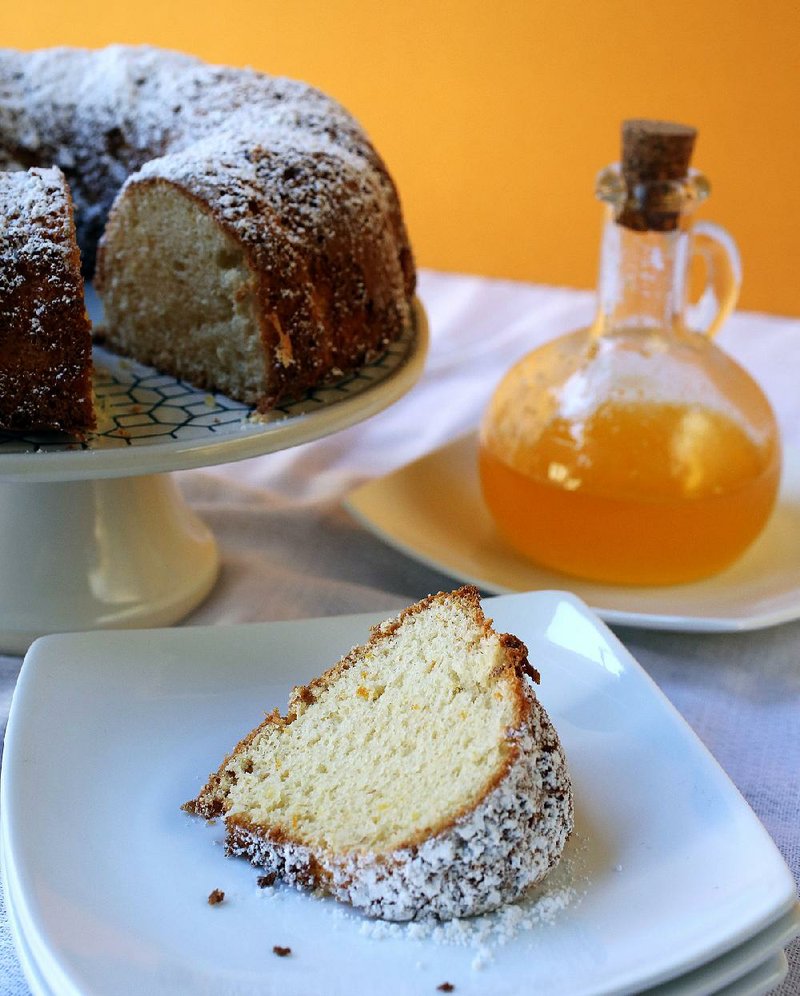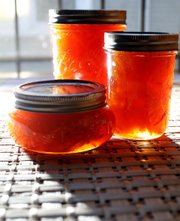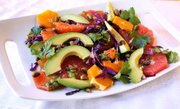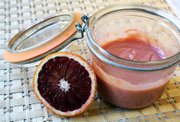The sky may be gray and nights may be long, but winter food needn't be dark and heavy like the blankets on our beds.
Citrus fruits in cheerful hues of red, pink, orange, yellow and green bring the taste of sunshine to our tables while delivering a seasonal boost of vitamin C and potassium.
A GUIDE TO CITRUS
Blood orange: A sweet-tart orange with bright, deep red or red-streaked flesh. This orange is originally from Sicily and is less acidic than other varieties. The Moro variety is the most dramatically colored blood orange.
Cara Cara: A sweet and juicy variety of navel orange with pink-blushed flesh.
Clementine: This thin-skinned, tangy-sweet member of the mandarin orange family -- a cross between the Mediterranean mandarin and an orange -- originated in Algeria. The fruit peels easily and is usually seedless, but sometimes contains large seeds.
Dekopon: These large mandarins are easily recognized by their bumpy skin and outie belly-buttonlike protrusion on the stem end. The juicy, sweet, seedless fruit was developed in Japan and is sold under the trade name Sumo.
Key lime: Key limes are super tart, smaller, rounder and more yellow than Persian (regular) limes.
Kumquat: This tiny citrus is about the size of a grape. The edible rind is sweet, the flesh is tart. The kumquat is usually served candied, pickled or cooked.
Meyer lemon: This fruit is sweeter and more aromatic than regular lemons. It originated in China and is believed to be a cross between a lemon and orange.
Navel orange: The most popular eating orange in the world. Its bright orange skin is easy to peel, and the fruit's juicy, sweet segments separate easily.
Pummelo: This ancestor to the grapefruit is native to Malaysia. The pummelo is more aromatic and sweeter than a grapefruit but can be used just like it. It has yellow skin with pink flesh.
Ruby Red grapefruit: Also called pink or red, this sweet grapefruit has pink-blushed skin with deep pink or red flesh and a sweet-tart flavor. Deeper colored flesh often indicates sweeter flavor.
Satsuma: This loose-skinned mandarin originated in China. It is one of the sweetest citrus varieties and is usually seedless.
Tangerine: A subclass of mandarin oranges, these sweet fruits peel easily and are less acidic than other citrus fruits. It is believed tangerines got their name when they were introduced to Europe via Tangiers.
Tangelo: This seedless, bell-shaped fruit is a cross between a tangerine and a grapefruit. It has skin similar to an orange with a noticeable bump on the stem end. Minneola and Honeybells are common varieties.
Ugli fruit: Also called Uniq fruit, this strange looking citrus is native to Jamaica and believed to be a tangerine-grapefruit hybrid. The thick, wrinkly, mottled yellow and green rind loosely encompasses the fruit. The flavor is similar to grapefruit with hints of orange.
Valencia orange: A favorite for juicing, these sweet, deep-orange-colored fruits have smooth, thin skin and are usually seedless.
Sources: The New Food Lover's Companion by Sharon Tyler Herbst, The Great Citrus Book by Allen Susser, Citrus: Recipes That Celebrate the Sour and the Sweet by Catherine Phipps and Melissa's Great Book of Produce by Cathy Thomas.
TIPS
• For recipes that will use the zest or entire fruit, opt for organic whenever possible and be sure to scrub the fruit under hot tap water to remove any waxy residue.
• Don't toss juiced citrus rinds. There's still loads of flavor to be extracted. Save the rinds to make an easy, no-cook citrus syrup (see recipes).
• Even if the recipe doesn't call for it, zest the fruit for easier juicing. The extra zest can be used to make citrus sugar: whirl granulated sugar and the citrus zest in a blender or food processor until well combined. Store in an airtight container.
Any Citrus Curd
1 cup citrus juice such as grapefruit, orange, mandarin, lemon or lime
1/2 vanilla seedpod, split lengthwise (optional)
Finely grated zest from 1 citrus fruit such as grapefruit, orange, mandarin, lemon or lime
4 tablespoons butter, softened
1/4 to 1/2 cup granulated sugar, depending on sweetness of fruit (see notes)
1 egg PLUS 2 egg yolks (see notes)
Pinch of salt
In a small saucepan, bring the juice and vanilla seedpod to a boil over medium-high heat; reduce heat and simmer until juice is reduced to about 3/4 cup.
Transfer the juice to a measuring cup to cool, and stir in the zest.
In a large glass or stainless-steel bowl, beat butter and sugar with an electric mixer until light and fluffy, about 2 minutes. Gradually add the egg and yolks, one at a time, beating on low speed until well combined. Increase speed to medium and beat 1 minute. Beating on low speed, drizzle in the cooled juice. The mixture will look curdled, but don't worry, this is OK.
Add enough water to a medium saucepan to fill by 1 inch. Bring to a boil; reduce heat to a bare simmer. Place the bowl with the juice mixture over the simmering water. Whisking constantly, cook mixture until it is smooth and thick, about 15 minutes. The mixture is ready when it is thick enough to coat the back of a wooden spoon and running your finger through it leaves a trail.
Cover the curd with plastic wrap, pressing the plastic to the surface of the curd and refrigerate until well chilled. Use within one week or freeze for up to two months.
Notes: If making lemon or lime curd, use the larger amount of sugar.
Use the egg whites to make meringue cookies to serve with the curd, if desired. Beat the whites until frothy, then add 1/4 teaspoon cream of tartar; beat 30 seconds, then slowly add 1/2 cup granulated sugar, beating to stiff, glossy peaks. Spoon or pipe into mounds and bake for 90 minutes at 225 degrees. Cool completely.
Makes 1 generous cup.
This Citrus Syrup is a revelation. The no-cook, no-waste recipe utilizes juiced citrus rinds (there must be pulp attached; peels alone will not work) and produces an intensely flavored and aromatic syrup. Almost any citrus will work, but lemon is especially good for flavoring beverages. The squeezed rinds will keep in a zip-close bag in the refrigerator for few days while you accumulate enough to make a batch of syrup. Another option is to juice all of the necessary juice at once and freeze the juice for later. Using zested citrus rinds is fine.
A kitchen scale is recommended for this recipe.
Citrus Syrup
15 ounces rinds from juiced citrus fruit (about 6 lemons, 8 limes, 2 1/2 medium oranges or 1 large grapefruit)
7 ounces granulated sugar (about 1 cup)
Cut rinds into 1-inch chunks.
In a glass or plastic bowl, combine rinds and sugar and toss to mix well. Set aside for 3 to 4 hours, stirring every hour or until sugar has completely dissolved. Or, let stand 8 to 12 hours, stirring less frequently.
Working in batches, press mixture through a potato ricer or several layers of cheesecloth to extract as much liquid as possible. Discard solids. Strain liquid into an airtight jar. Syrup will keep, refrigerated, for up to 3 months.
Makes 1/2 to a scant cup, depending on the fruit.
Recipe adapted from seriouseats.com
One of our favorite ways to bring the bright flavors of citrus to our table year-round is to make marmalade. The following marmalade is more "rustic" than what you'd buy at the store, but it's also a flavor you're not likely to find on a store shelf.
Clementine-Saffron Marmalade
2 1/4 pounds clementines or mandarins such as Halos
2 1/2 tablespoons bottled lemon juice
5 1/2 cups granulated sugar
Generous pinch saffron threads
Peel fruit. Thinly slice the peels and place in a large nonmetal bowl. Separate the fruit into segments, removing any loose, stringy membranes. Coarsely chop the segments and place them and any accumulated juices in the bowl with the sliced peels. Add 8 cups water and the lemon juice. Cover and let stand 8 to 16 hours.
Prepare jars and lids for water-bath canning. For detailed, step-by-step instructions on preparing a boiling water canner, canning jars and lids, visit tinyurl.com/mnq9tsv. (If water bath canning is not desired, the unprocessed marmalade can be refrigerated for 1 month or frozen for up to a year.)
Place a small plate in the freezer.
Transfer the fruit and soaking liquid to a large stockpot. Bring to a boil over medium-high heat. Add sugar and stir to dissolve. Add saffron and stir well. Return mixture to a boil and cook, stirring frequently to prevent scorching, for 40 minutes or until the marmalade jells. To test it, remove the plate from the freezer and place a small spoonful of marmalade on the frozen plate and return it to the freezer for 1 minute. If it forms a skin and wrinkles when nudged, it's ready.
Ladle marmalade into the prepared jars, leaving ¼-inch head-space. Wipe rims clean with a damp cloth. Center lids on rims. Screw on bands until fingertip tight -- just until you meet resistance. Place jars in canner, add water to cover jars by 1-inch and process for 10 minutes. Remove jars to towel-lined counter and let stand undisturbed for 12 to 24 hours.
Test seals by pressing the center of each lid. If it flexes, the lid did not seal. Reprocess or refrigerate any unsealed jars immediately. Sealed jars will keep in a cool, dark place for up to 18 months.
Makes about 5 half-pints.
Recipe adapted from East/West: A Culinary Journey Through Malta, Lebanon, Iran, Turkey, Morocco and Andalusia by Shane Delia
To turn this salad into a meal, serve it over a bed of quinoa and double the greens.
Citrus and Avocado Salad With Cumin-Lime Vinaigrette
6 citrus fruits such as combination of grapefruit, oranges and mandarins
1 small clove garlic
Salt
2 limes
1/4 to 1/2 teaspoon coarsely ground cumin seeds
1/4 teaspoon ground coriander
Pinch crushed red pepper flakes such as Aleppo
4 tablespoons olive oil
2 green onions, finely sliced
2 tablespoons finely chopped cilantro, plus a few whole leaves
1 to 2 ripe avocados
Several handfuls shredded radicchio, red cabbage, napa cabbage or romaine lettuce or a combination
1/4 cup pistachio nuts
Cut a slice off the top and bottom of each citrus fruit so that the fruits stand on a cutting board without wobbling. Using a sharp knife, carefully cut down the sides of each fruit to remove the peel and all of the white pith. Cut fruits into 1/4-inch rounds.
Place the citrus and any accumulated juices in a large bowl or serving platter; set aside.
Mash garlic with salt to form a smooth paste.
Using a rasp-style grater such as a Microplane, remove the zest from 1 lime. Juice both limes.
In a small bowl, whisk together the lime zest and juice, the garlic-salt paste, the cumin, coriander, pepper flakes and olive oil. Stir in green onion and chopped cilantro.
Halve the avocado(s) and slice the flesh lengthwise. Discard pit and skin. Add the sliced avocado to the citrus. Pour dressing over and scatter with greens, pistachios and cilantro leaves. Toss gently just before serving.
Makes 2 to 4 servings.
Recipe adapted from In My Kitchen: A Collection of New and Favorite Vegetarian Recipes by Deborah Madison
Citrus Chiffon Cake
Vegetable oil or coconut oil, for greasing pan
1 cup cake flour
3/4 cup granulated sugar, divided use
1 teaspoon baking powder
1/2 teaspoon salt
3 eggs, separated
5 tablespoons canola oil
1/3 cup fresh orange juice
2 teaspoons finely grated fresh orange zest
2 teaspoons finely grated fresh lemon zest
1 teaspoon vanilla extract
1/2 teaspoon cream of tartar
Confectioners' sugar, for dusting
Citrus Syrup, optional
Heat oven to 350 degrees. Grease and flour a 10-cup tube or Bundt pan.
In a large bowl thoroughly whisk together the flour, 1/2 cup of the sugar, the baking powder and salt.
In a small bowl whisk together the egg yolks, oil, orange juice, zests and vanilla. Whisk mixture into flour mixture until batter is smooth.
In a separate large bowl, beat egg whites with an electric mixer until frothy. Add the cream of tartar and continue beating until soft peaks form. Gradually add the remaining 1/4 cup granulated sugar and beat until whites hold stiff, glossy peaks. Stir about one-third of the whites into the batter to lighten it, and then fold in the remaining whites gently but thoroughly. Spoon batter evenly into the pan.
Bake cake 40 minutes or until a wooden pick inserted near the center comes out clean. Immediately invert pan onto a rack and cool cake completely in pan upside down on rack. If necessary, run a thin knife around outer edge of pan to release cake and turn cake out of pan onto a serving plate. Serve dusted with confectioners' sugar and drizzled with Citrus Syrup, if desired.
Recipe adapted from Gourmet
Food on 02/07/2018




